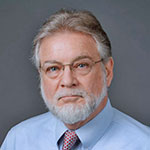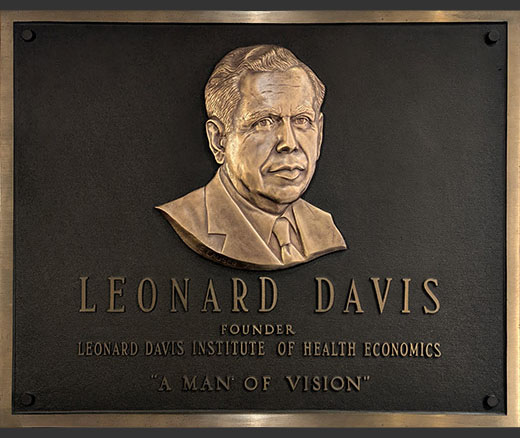
Understanding the Evidence: SNAP and Health
Six Studies That Highlight How Losing SNAP Can Raise Food Insecurity and Affect Health
News

For its 2024 annual University of Pennsylvania Alumni Weekend Panel Discussion on May 17, the Leonard David Institute of Health Economics (LDI) brought together three rising health services research scholars to discuss what’s working and what’s not in the various care delivery innovation areas they’re involved in.
Moderated by LDI Executive Director Rachel M. Werner, MD, PhD, the event occurred in Houston Hall on the Penn campus and focused on policies and practices in primary care, nursing, and genetic and lab analytical services. All LDI Senior Fellows, the panelists were George Dalembert, MD, MSHP, the Founding Director of the Children’s Hospital of Philadelphia (CHOP) Medical Financial Partnership; Halley Ruppel, PhD, RN, a core faculty member at the Clinical Futures, A CHOP Research Institute Center of Emphasis; and Anna Wexler, PhD, of the Perelman School of Medicine Department of Medical Ethics and Health Policy. This is a synopsis of what they discussed;
“One of the biggest issues in care delivery innovations is the way some innovations produce the opposite of what the hospital thought they would achieve,” said Ruppel, a Research Assistant Professor at the University of Pennsylvania School of Nursing who focuses on how systems and technologies are integrated into hospital operations.

She pointed to devices and practices that are theoretically supposed to address widespread stress and burnout among nurses but instead add to the stress that drives nurse burnout.
“If you’ve been in a hospital lately, you know about all the inpatient monitors like vital sign monitors, IV pumps, ventilators, and others that just keep being added and that greatly impact nursing,” Ruppel said. “Even when those innovations do take away some of the work, they’re often creating new work. With monitors, that includes not only setting up the device, but also having to respond to alarms that are often not actionable or necessary and cause quite a burden, particularly in high-risk situations.”
She pointed out that it is now common for hospitals to issue iPhones to nurses and clinicians to be used as a facility-wide communication system. “These phones are going off with alarms in addition to messages from the clinical teams and so forth,” Ruppel said. “In intensive care units (ICUs), nurses spend a lot of their time delivering medications that can be deadly and that require a very tight focus on the task at hand. The nurses are often getting messages from the leadership telling them they need to avoid being distracted or interrupted when they’re doing this. Yet, their phones are ringing alarms at them constantly. Some studies estimate there’s an alarm from just one of the common monitoring devices–the vital signs monitor–about every 5 to 10 minutes.”
“There’s a kind of moral distress that comes with all of this. You’re doing something important, and an alarm goes off. You must decide, is this so important that I need to stop what I’m doing and respond to it or not? There have been many cases where the wrong decision has been made or an alarm has been missed, and something bad has happened to a patient that the nurse couldn’t respond to,” Ruppel said.
A recent survey at the Penn School of Nursing’s Center for Health Outcomes and Policy Research (CHOPR) asked 2,100 nurses across the country about this issue and 85% of them reported they were overwhelmed by alarms. In addition, 81% said they routinely must delay responding to alarms because they’re busy with something else. “We found a strong association between alarm burden and levels of burnout,” said Ruppel. “So, these innovative technologies are contributing to the very burnout pressures they were supposed to be reducing.”
“Another innovation area of concern for nurses is that we’re seeing more and more products and devices developed or purchased to solve problems that nurses don’t actually have,” said Ruppel. “We need to reframe the innovation process in a way that more fully engages nurses and other clinicians in the identification of what the problem is that actually needs to be solved.”
“The situation of poverty and health gives us an opportunity to really think innovatively about what it means to provide health care and think about impacting poverty through what we call medical financial partnerships,” said Dalembert, an Assistant Professor of Clinical Pediatrics at the Perelman School. “If we just focus on health care delivery as we have classically done, we are not going to be able to attain the full potential of our health care systems to improve the health and well-being of the patients and communities that we serve.”

“Those of us who have studied this challenge know how big a barrier the social determinant of poverty is to health,” he continued. “About 11-12% of the U.S. lives in poverty. That number gets worse when you consider kids, and the number bumps up to 15-16%. And if you break that down for Philadelphia, that number doubles to more than 30% of them living in poverty. That’s our backdrop. That’s West Philly right up the street from here where our families are navigating to take care of their kids.”
“My approach to this has been to address some of those underlying drivers of a family’s ability to meet their needs through what we call medical financial partnerships where we work with local community organizations to deliver services that improve people’s financial health.”
“One of the most evidence-based ways to address poverty is through tax credits,” Dalembert said. “We have worked with a local organization over the past five years to help our local families access close to $2 million in tax credit refunds. That’s money that’s been infused back into the community to help both those individuals, as well as the family systems that they come from, to achieve their needs. We actually have a financial counselor available to patients and families, and that service has helped them increase their credit scores by 50 plus points.”
“That’s helped people to decrease their debt, that’s helped them to become first-time homeowners and thereby start to have a healthy home where they can grow up in and generate some intergenerational wealth that they can pass on to their kids and start to shift the system more broadly. The initiative also looks towards the future education piece. It’s proven that higher education is associated with increased income. And so, we work with the program that’s shown that having child savings accounts makes it three times more likely to have a child go to college, four times more likely to have that child finish college. We are helping people set their kids up for that and make up for not having a lot of money by having a lot of time. So, if you start with a baby and start saving, you’ll have more money by the time they’re ready for higher education.”
“All of this is done through community partnership, which I think is part of the secret sauce,” said Dalembert. “We don’t have to do all of this by ourselves. We don’t have to add tax preparation to the medical school curriculum, but we do have to think creatively about how we innovate to solve the problems that underlie health. And I think that’s a key to moving our systems forward.”
Wexler studies emerging innovation trends in the previously little-known fields of direct-to-consumer medical services. She began by pointing to the direct-to-consumer genetic testing site 23andMe that originally provided consumers with ancestry information derived from DNA in their submitted saliva. The company has expanded to lead what is becoming a crowded market of firms that analyze customer’s submitted DNA to identify genetic variants that may increase the risk for certain kinds of diseases and other health care biometrics. Other testing labs like Quest and LabCorp that used to exclusively perform blood analysis tests for physicians and medical facilities have now also expanded their system to provide the same kinds of tests directly to consumers.

“The pitch is: ‘No doctor visit required. Understand your health on your own terms,'” said Wexler. “The costs are very transparent and low, and the process is very simple. It’s like Amazon. You click and add the test you want to your cart and check out and pay. You also click to schedule your appointment to have your blood drawn. A week later, you log back into the lab’s online portal to see your results.”
“Beyond these lab services, we also have direct-to-consumer orthodontics, mental health care and even prescription drugs. For the drugs, you go online and order the medication. Sometimes there’s a ‘ghost’ physician in the loop behind the scenes ordering the medication. All of these models flip the traditional model of health care on its head.”
“So, what about the ethics of all this?” Wexler asked. “We certainly have some concerns with this sort of health care delivery model, one of the most important being the privacy of health information. In my lab, we did a study of the privacy policies of 21 different direct-to-consumer lab testing companies–not the ones that offer the prescription medication, but the ones where you can go and get lab tests. We looked at their policies and whether they say anything about whether they comply with the Health Insurance Portability and Accountability Act (HIPAA).”
“Less than half said that they comply with HIPAA. One said that they did not comply with HIPAA and 10 others had no information about whether they comply with HIPAA. A little more than half of the companies said that they can share their data for ‘research and development’ purposes, either internally or with external organizations. They did not provide information about that data sharing. So, it’s unclear how well the data that consumers give to these companies is actually being protected.”
“Another issue is the lack of follow-up, especially in cases where there are abnormal results on the lab test. Our study found that while the majority of the companies did provide consumers with the option to follow up, or they said there would be an option to follow up, it was often unclear who initiates the follow-up and what type of health care professional is involved or if there was a health care professional at all involved.”
“And there’s accountability and liability concerns related to abnormal results. If something goes wrong with the test or something bad happens to the consumer, who is liable and accountable? There may be a ‘ghost’ physician doing the ordering but not a physician who is accountable in the traditional way that we think about medical accountability,” said Wexler.


Six Studies That Highlight How Losing SNAP Can Raise Food Insecurity and Affect Health

Includes $1 Million in Donations to Meet a Matching Challenge

Government Regulatory Power Wanes as Power Accrues to Courts and Corporations

Temporary Shutdown Losses are Only the Beginning: New Rules Under the One Big Beautiful Bill Act will Shrink SNAP Benefits, and Worsen Food Insecurity for Millions Across the U.S.
Research Brief: Shorter Stays in Skilled Nursing Facilities and Less Home Health Didn’t Lead to Worse Outcomes, Pointing to Opportunities for Traditional Medicare

A New Call to Action Urges Three Ways State and Local Leaders Can Act To Ban Additives, Improve Food Labels, and Restrict Marketing to Children